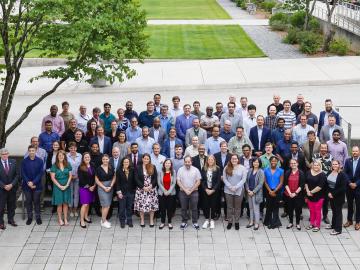
Filter News
Area of Research
- (-) Fusion and Fission (19)
- (-) Materials (76)
- (-) National Security (26)
- Advanced Manufacturing (1)
- Biological Systems (1)
- Biology and Environment (56)
- Building Technologies (1)
- Clean Energy (63)
- Computational Engineering (1)
- Computer Science (2)
- Electricity and Smart Grid (1)
- Energy Sciences (1)
- Fuel Cycle Science and Technology (1)
- Fusion Energy (3)
- Isotope Development and Production (1)
- Isotopes (15)
- Materials Characterization (2)
- Materials Under Extremes (1)
- Neutron Science (32)
- Nuclear Science and Technology (2)
- Supercomputing (73)
News Topics
- 3-D Printing/Advanced Manufacturing (5)
- Advanced Reactors (3)
- Artificial Intelligence (7)
- Big Data (1)
- Bioenergy (2)
- Biomedical (2)
- Buildings (3)
- Chemical Sciences (17)
- Climate Change (3)
- Composites (2)
- Computer Science (4)
- Coronavirus (1)
- Critical Materials (4)
- Cybersecurity (7)
- Decarbonization (6)
- Energy Storage (5)
- Environment (4)
- Exascale Computing (1)
- Frontier (1)
- Fusion (8)
- Grid (3)
- High-Performance Computing (4)
- Irradiation (1)
- Isotopes (4)
- Machine Learning (6)
- Materials (41)
- Materials Science (7)
- Microscopy (3)
- Molten Salt (1)
- Nanotechnology (3)
- National Security (14)
- Net Zero (2)
- Neutron Science (8)
- Nuclear Energy (15)
- Partnerships (10)
- Physics (9)
- Polymers (4)
- Quantum Computing (2)
- Quantum Science (1)
- Renewable Energy (1)
- Security (2)
- Simulation (3)
- Sustainable Energy (2)
- Transportation (3)
Media Contacts

Leigh R. Martin, a senior scientist and leader of the Fuel Cycle Chemical Technology group at ORNL, has been named a Fellow of the American Chemical Society for 2023.

ORNL, the Department of Energy’s largest multidisciplinary laboratory, and Fairbanks Morse Defense, a portfolio company of Arcline Investment Management, have entered into a Memorandum of Understanding to collaborate on the development and integration of alternative fuel technologies aimed at reducing the marine engine’s reliance on fossil fuels.

Since its inception in 2010, the program bolsters national scientific discovery by supporting early career researchers in fields pertaining to the Office of Science.

ORNL hosted its fourth Artificial Intelligence for Robust Engineering and Science, or AIRES, workshop from April 18-20. Over 100 attendees from government, academia and industry convened to identify research challenges and investment areas, carving the future of the discipline.

After completing a bachelor’s degree in biology, Toya Beiswenger didn’t intend to go into forensics. But almost two decades later, the nuclear security scientist at ORNL has found a way to appreciate the art of nuclear forensics.

Dean Pierce of ORNL and a research team led by ORNL’s Alex Plotkowski were honored by DOE’s Vehicle Technologies Office for development of novel high-performance alloys that can withstand extreme environments.

Xiao-Ying Yu, a distinguished scientist at the Department of Energy’s Oak Ridge National Laboratory, has been named a Fellow of AVS: Science and Technology of Materials, Interfaces, and Processing, formerly American Vacuum Society.

When geoinformatics engineering researchers at the Department of Energy’s Oak Ridge National Laboratory wanted to better understand changes in land areas and points of interest around the world, they turned to the locals — their data, at least.

Research into a new, unique technology to fabricate composite metal parts for a wide range of applications operating in extreme environments across the aviation, space and energy industries is showing promise for additive manufacturing.

Experts across varied technology fields gathered ORNL to collaborate on the future of geospatial systems at the Trillion-Pixel GeoAI Challenge workshop. The third iteration of this event focused on multimodal advances in the field, including progress in artificial intelligence, cloud infrastructure, high-performance computing and remote sensing. These capabilities, when combined, can help solve problems in national and human security such as disaster response and land-use planning.


